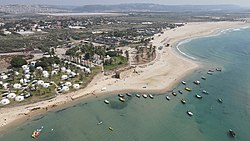Dor, Israel
Dor
דּוֹר | |
|---|---|
 Dor beach | |
| Coordinates: 32°36′27″N 34°55′19″E / 32.60750°N 34.92194°E | |
| Country | |
| District | Haifa |
| Council | Hof HaCarmel |
| Affiliation | Moshavim Movement |
| Founded | 2000 BCE (Tel Dor) 838 CE (Tantura) 1949 (Israeli moshav) |
| Population (2022)[1] | 465 |
Dor (Hebrew: דּוֹר) is a moshav in northern Israel. Located near Zikhron Ya'akov, it falls under the jurisdiction of Hof HaCarmel Regional Council. In 2022 it had a population of 465.[1]
Named after the ancient Phoenician city of Dor, the moshav was established in June 1948 on land of the recently depopulated Palestinian village of al-Tantura in the wake of the Tantura massacre.[2]
History
[edit]Tel Dor
[edit]The earliest remains at the Tel Dor site date back to the Canaanite period ending about 1200 BCE. Later, the Shkil tribe of sea raiders inhabited Tel Dor, as described in the letters of the Egyptian traveler Wen-Amon.[3] The Phoenicians settled at Dor approximately 1100 BCE, and subsequently it became King Solomon's main port on the Mediterranean. Modern Dor was named[4] after the ancient Phoenician city of Dor, which was inhabited by the tribe of Manasseh in the Israelite period. The city is mentioned in the Bible, in the Book of Joshua 17:11 and 1 Chronicles 7:29). The ancient city of Dor was situated on the excavated tell north of today's moshav, overlooking Kibbutz Nahsholim.
Archaeologists have excavated Roman temples and mosaic floors, as well as stone-walled houses from the Hellenistic period, when the site was known as Dora.[3] Artifacts of beautiful Roman and Greek bowls, plates, jugs and jewelry are displayed at the nearby museum. From the 4th to the 7th century CE, Dor served as a Bishopric, but the Byzantine church was later abandoned.[3] The village of Tantura was established in the area during the Arab period.[3]
Moshav site
[edit]
The modern moshav was established in 1949 by Jewish immigrants from Greece, who were later joined by Jewish refugees from Iraq on land of the forcibly depopulated Palestinian village of Tantura, east of the old village site.[6][7] Today, according to a report in the newspaper Haaretz, a car park for the beaches of Dor and neighboring Nahsholim contains a mass grave from the 1948 Tantura massacre.[5]
References
[edit]- ^ a b "Regional Statistics". Israel Central Bureau of Statistics. Retrieved 21 March 2024.
- ^ Confino, Alon (2015). "The warm sand of the coast of Tantura: History and Memory in Israel after 1948". History & Memory. 27: 43–82. doi:10.2979/histmemo.27.1.43.
- ^ a b c d Life with Neanderthal Man and Napoleon too at the Mt. Carmel caves and the beach at Tel Dor Sightseeing in Israel
- ^ Carta's Official Guide to Israel and Complete Gazetteer to all Sites in the Holy Land. (3rd edition 1993) Jerusalem, Carta, p. 137, ISBN 965-220-186-3
- ^ a b Adam Raz, 'There’s a Mass Palestinian Grave at a Popular Israeli Beach, Veterans Confess,' Haaretz, 20 January 2022.
- ^ Morris, Benny (2004). The Birth of the Palestinian Refugee Problem Revisited. Cambridge: Cambridge University Press. p. xxii. ISBN 978-0-521-00967-6.
- ^ Khalidi, Walid (1992). All That Remains: The Palestinian Villages Occupied and Depopulated by Israel in 1948. Washington D.C.: Institute for Palestine Studies. p. 195. ISBN 0-88728-224-5.


